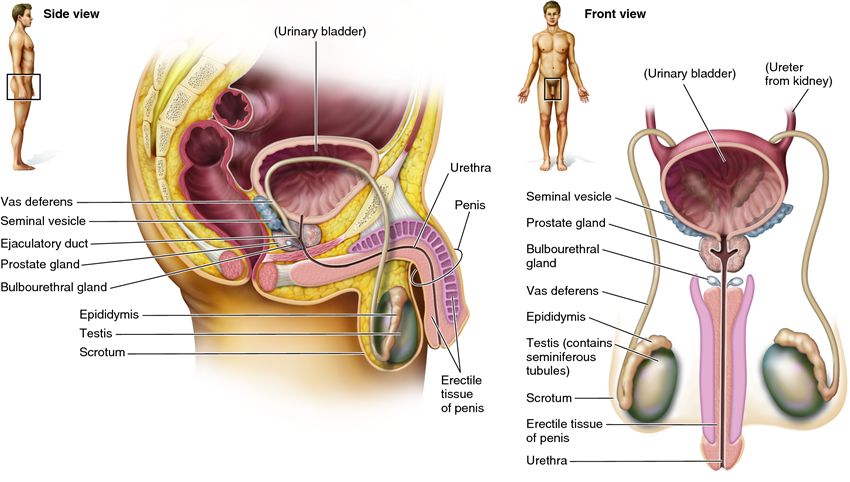With so many questions, myths, and misinformation regarding how our bodies work, I thought I’d create a series of posts to help enlighten and educate. This post will cover the male reproductive system, with an emphasis on sperm, semen, and pre-cum.
Sperm
Where does the word “Sperm” come from?
The word “Sperm” comes from the Greek word “sperma” ~ meaning “seed”. It is also short for the word “spermatozoon” or “spermatozoa” (the plural), which are the technical names for mature sperm cells.
What are Sperm?
Sperm are elongated cells (resembling tadpoles) consisting of 3 main parts; the head, body (or mobile piece) and tail. Along with the three main parts sperm have two smaller parts; the neck and acrosome.
The Head
The head of the sperm is what once was the cell nucleus (or germ cell). Through maturation and transformation the germ cell changes form and becomes the head. It contains, in its compressed and folded form, half (23 chromosomes) of the genetic material to make a baby when joined with a females egg.
The Body
The body or mobile piece, joined to the head by the neck, contains a series of mitochondria that help to power the movement of the tail.
The Tail
The main purpose of the tail is to help the sperm float and carry the genetic material to the female egg. The tail, or flagellum as it’s technically termed, does this by propelling the sperm (at about 1–3 mm/minute in humans) by whipping in a circular motion (think of a boat propeller).
The tail can vary in size depending on the sperm and often time sperm have been found to have two tails or two heads.
Once the sperm has reached the egg and has completed its task, the tail breaks off and is discarded.
The Acrosome
Over the head of the sperm is the acrosome. Packed full of digestive enzymes, the acrosome helps the sperm to penetrate the egg by breaking down its various protective layers.
How are Sperm made?
Sperm are made through a process called Spermatogenesis. The process of creating a fully mature sperm usually takes between 65 – 74 days from the time it is a germinal cell in the testicle, to being divided and transformed into sperm.
What is the process of Spermatogenesis?
Sperm cells start out in tiny lobules in the testicles as spermatogonia. These cells are only found in small quantities before the male reaches puberty. Once puberty is reached the underdeveloped cells divide incessantly to create 2 other types of cells;
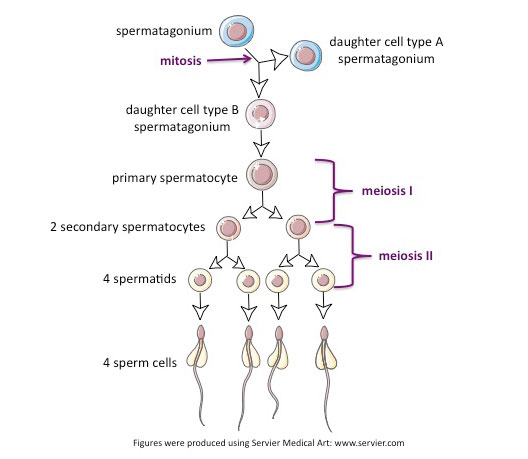 The first set of cells, are copies of the original spermatogonia which continue to create more spermatogonia.
The first set of cells, are copies of the original spermatogonia which continue to create more spermatogonia.- The second set of cells, continue to grow and mature without dividing and create spermatocytes. The spermatocytes continue to develop into spermatids which become spermatozoa or mature sperm, as most of us know them.
- In total each cell will make four copies that will then develop into mature reproductive cells.
- If the original underdeveloped spermatogonia are killed or damaged, the man will become sterile because he will no longer have the resources necessary to create new sperm.
Where are Sperm made?
Sperm develop in the testicles within a system of tiny tubes called the seminiferous tubules.
How does the Sperm get from being inside the testicles to being ejaculated?
The sperm exit the testicle through the epididymis, found at the rear of each testicle. They continue through the vas deferens where they finally join with the seminal vesicles forming the ejaculatory duct. Here, the vas deferens and seminal vesicles meet and secretions from the seminal vesicles and sperm are stored. From this point, the ejaculatory ducts pass through the prostate gland, where the sperm receive more secretions, then join with the single urethra (tube through which sperm and urine pass out of body) and out the urethra meatus (opening of the penis).
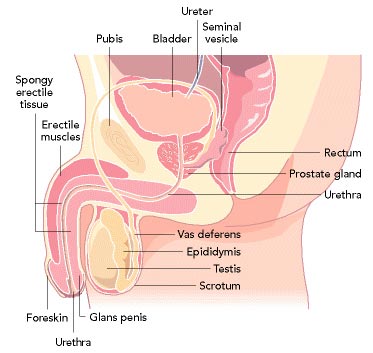 *Image taken from www.fertility.com
*Image taken from www.fertility.com
What is the Epididymis?
The Epididymis is a tightly coiled tube located on the top of the testes (think of a spring or a slinky). Stretched out, it would measure approximately 6 metres in length. The sperm are stored in the epididymis for up to 2 weeks, during this time the sperm are subjected to major environmental changes due to testosterone-dependent secretions. As a result, sperm not only acquire the ability to swim but they also change in the way they utilize and break down energy substrates, and finally reach full fertilizing capacity. The epididymis also acts as a reservoir (think of a piggy bank), storing millions of mature sperm until ejaculation. In the absence of ejaculation sperm dribble into the urethra and are washed away in the urine.
Sperm obtained before their passage through the epididymis are incapable of fertilizing an egg even if implanted directly.
From the epididymis the sperm move to the vas deferens.
What is the Vas Deferens?
The male reproductive system has two vas deferens (or spermatic cords) varying in length between 28 -30 centimetres. The vas deferens are long, tube-like structures, which connect the left and right epididymis to the urethra. During ejaculation the smooth muscle in the walls of the vas deferens contracts continuously, thus propelling the sperm forward to meet the seminal vesicles.
What are the Seminal Vesicles?
The primary purpose of the vesicles is to supply a viscous, alkaline secretion that forms as part of the seminal fluid. Although the sperm do not travel through the seminal vesicles, the vesicles do play a vital role in sperm survival.
- The fluid from the seminal vesicles, usually contribute more than half of the seminal volume. Their secretions are particularly rich in a sugar (called fructose), which is an essential energy source for the sperms metabolism, as well as enhances sperms motility.
- The vesicles also produce a substance that causes the semen to clot (become sticky or jelly-like) after ejaculation, thought useful in reproduction for keeping the semen at the neck of a woman’s womb.
- In regard to appearance, the seminal vesicles are two pouches located behind the bladder above the prostate gland that are about 5 to 7cms (2 to 2.75 inches) in length by about 2 to 3 cm wide.
- In each vesicle is a tubule that is about 15cm long that is coiled; surrounding this is connective tissue made of blood, lymphatic vessels, nerve fibres and supportive tissue. The tubule itself is composed of three layers; the inner lining, a moist and folded mucous membrane; a muscle layer; and a fibrous outside covering of elastic tissue.
- During ejaculation, the muscular tissue and elastic fibres contract to empty the vesicle’s contents into the ejaculatory ducts shortly after the vas deferens has emptied the sperm into those ducts.
What are Ejaculatory Ducts?
The ejaculatory ducts are two hollow tubes, each formed by the union of the ampulla of the vas deferens and the excretory duct of a seminal vesicle. The ducts, which open into the urethra about halfway through the prostate gland, function to mix the sperm stored in the ampulla with fluids secreted by the seminal vesicles (think of a blender) and to transport these substances to the prostate.
What is the Prostate Gland?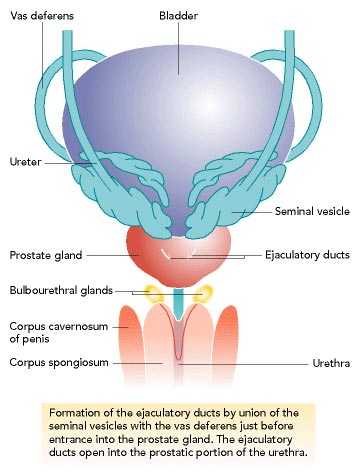
The prostate glands’ main function is to store and secrete an alkaline (pH7.29) fluid (filled with proteins and hormones) that usually appears thin, white and milky. The reason for the alkalinity of prostate fluid is that it helps neutralize the acidity of the vaginal tract, prolonging the lifespan of sperm. Without the protective fluid provided by the prostate, very few sperm cells would ever reach the egg.
The prostatic fluid is released in the first ejaculate fractions together with most of the sperm, making up 25-30% of the volume of the semen along with sperm and seminal vesicle fluid. In comparison with the few sperm expelled together with mainly seminal vesicular fluid, those expelled in prostatic fluid have better motility, longer survival and better protection of the genetic material (DNA).
The prostate gland it self, comprised of glandular tissue and non-glandular tissue, is the largest of all the male reproductive glands. Resembling a walnut, the prostate sits directly below the bladder and in front of the rectum. Specifically, the prostate is two inches above the perineum which are the muscles and exterior skin between the scrotum and anus.
During ejaculation, the prostate gland and the surrounding muscles contract, expelling the semen out of the body through the urethra (tube through which sperm and urine pass out of body).
Semen
What is Semen?
Semen is a white, yellowish or grey liquid, that can be sticky, fluid, thick, or thin. Usually, each millilitre of semen contains millions of sperm, but the majority of the volume consists of fluid from the glands in the males reproductive organs, broken down in the following ways; 46 – 80% of fluid from the seminal vesicles, 13 – 33% from the prostate, 5% from the testicles and epididymis and 2 -5% from the Cowpers and urethral glands.
What does Semen smell or taste like?
Semen usually appears as an opalescent or shiny white fluid that gets clear and runny within minutes after ejaculation. Often, semen has a chemical or pungent odour that resembles chlorine. The different parts of semen have different tastes; for example, the component from the seminal vesicle, which is high in fructose (sugar), will be slightly sweeter than the rest of the fluid. That said semen characteristics do vary from person to person, and from month to month.
What happens to Semen once it’s left the males body?
Semen clots almost immediately after ejaculation, forming a sticky, jelly-like liquid. It is quite normal for semen to form jelly-like globules or small lumps and this usually does not indicate any health or fertility problem.
Pre-Cum
What is Pre-Cum?
Pre-cum or pre-ejaculate is a clear, or light whitish, slippery fluid produced by man’s bulbourethral glands (or Cowper’s gland) during sexual arousal.
What is the Cowper’s gland or Bulbourethral Gland?
The Cowper’s glands (or bulbourethral glands) are pea-sized glands located behind and to the side of the urethra in the male that discharge a spurt of seminal fluid into the urethra.
What does Pre-Cum do?
Pre-ejaculatory fluid’s main purpose is to clean out any bacteria or leftover urine or sperm from the urethra before ejaculation. It also acts as a natural lubricant for the easy passage of sperm.
Can a girl get pregnant from Pre-Cum?
Yes, it is possible to get pregnant from pre-cum as it may contain sperm that remained in the urethra following a previous ejaculation.
Sperm facts
- There are about 200-500 million sperm in the average amount of semen produced each time a man ejaculates.
- Mature sperm can wait up to 2 weeks for their big day – waiting in the epididymis – the coil like structure that runs across the top of each testicle
- If they are not ejaculated, sperm are broken down and reabsorbed by the body.
- Semen only contains about 10% sperm – the rest consists of enzymes, vitamin C, calcium, protein, sodium, zinc, citric acid and fructose sugar.
- What men eat can affect the taste of their sperm. Red meat, dairy products, onions, garlic, and coffee may not go down as well as foods containing natural sugars, such as fruits.
- Healthy males produce about 70-150 million sperm a day – but when they ejaculate, they can lose 3 times that amount due to stored sperm.
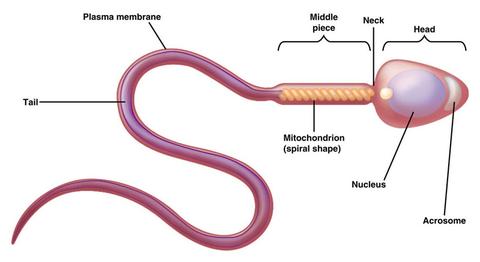
- When inside a woman’s body, a sperm can live from 5-7 days
- The average volume of ejaculate is around a half-teaspoon
- Ejaculate does not have a significant amount of calories. You’d have to ingest 400 loads to equal the calorie content of a “death by chocolate” dessert
- Immature sperm are present in baby boys but need the puberty hormone surge to make them grow into big sperm.
- It only takes one sperm to get a woman pregnant! Sperm has to get into the woman’s vagina for there to be any possibility of her getting pregnant.
- Sperm doesn’t have to get into the vagina only via the penis. A woman can get pregnant if the sperm is on someone’s fingers and they put their fingers into her vagina, or if the man ejaculates very near the entrance to her vagina.
- Sperm have a long journey to make to get to the egg, and most of them never make it. They travel from the vagina, through the cervix, up the womb and into the fallopian tubes.
- Studies show that some sperm reach the fallopian tubes in as little as 5 minutes after the man ejaculates. But most take 45 minutes or more.
*Facts taken from:
fitsugar.com, ivillage.com, and kidzworld.com.
Sign up to my mailing list and stay up to date! Don’t worry, I promise I won’t spam you.


